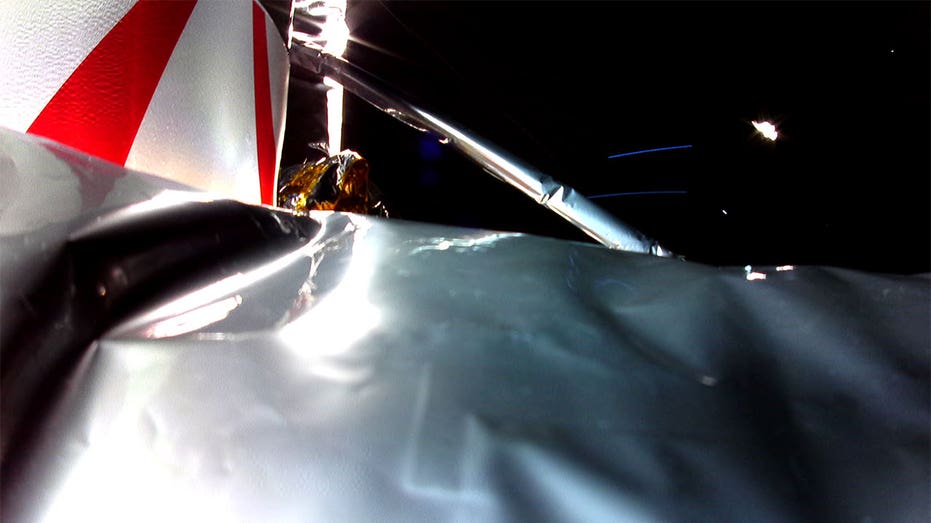Moon landing: 'No chance' of soft lunar landing for US mission after critical failure
Astrobotic Technology has abandoned its moon landing mission after a propulsion system failure caused the spacecraft carrying its Peregrine lander to lose fuel
Private US moon launch has technical issues
Fox News correspondent Jonathan Serrie reports on Astrobotic Technology saying its engineers are working to fix the ‘anomaly’ affecting the lunar lander failure.
There is "no chance" the first U.S. moon landing mission in more than 50 years will make a soft landing on the moon after suffering a "critical loss of propellant."
In an update Tuesday at noon, Astrobotic Technology said the solar batteries on its Peregrine lunar lander are at full charge, but the spacecraft carrying the lander will run out of fuel in approximately 40 hours.
"Given the propellant leak, there is, unfortunately, no chance of a soft landing on the Moon," Astrobotic said in a statement.
| Ticker | Security | Last | Change | Change % |
|---|---|---|---|---|
| LMT | LOCKHEED MARTIN CORP. | 466.03 | +0.33 | +0.07% |
| BA | THE BOEING CO. | 184.31 | -1.11 | -0.60% |
"However, we do still have enough propellant to continue to operate the spacecraft," the company added. "The team has updated its estimates, and we currently expect to run out of propellant in about 40 hours from now — an improvement from last night's estimate."
US MOON LANDING MISSION IN JEOPARDY DUE TO ‘CRITICAL LOSS’ OFF FUEL

This illustration provided by Astrobotic Technology in 2024 depicts the Peregrine Lunar Lander on the surface of the moon. (Astrobotic Technology/AP / AP Images)
On Monday, Astrobotic said the thrusters preventing its Peregrine lunar lander from tumbling uncontrollably through space are quickly losing fuel.
"An ongoing propellant leak is causing the spacecraft's Attitude Control System (ACS) thrusters to operate well beyond their expected service life cycles to keep the lander from an uncontrollable tumble," Astrobotic said. Those thrusters are currently keeping the lander pointed at the sun to charge its solar battery.
"If the thrusters can continue to operate, we believe the spacecraft could continue in a stable sun pointing state for approximately 40 more hours, based on current fuel consumption," Astrobotic estimated.
The new time frame would give the spacecraft until Thursday before it runs out of fuel.
US SEES SUCCESSFUL LAUNCH OF VULCAN ROCKET, PAVING THE WAY FOR FIRST MOON LANDING BY PRIVATE COMPANY
"At this time, the goal is to get Peregrine as close to lunar distance as we can before it loses the ability to maintain its sun-pointing position and subsequently loses power," Astrobotic said Monday.
The company added Tuesday that Peregrine is "in a stable operating mode and we are working payload and spacecraft tests and checkouts. We continue receiving valuable data and providing spaceflight operations for components and software related to our next lunar lander mission, Griffin."

The United Launch Alliance's Vulcan Centaur lifts off from Space Launch Complex 41d at Cape Canaveral Space Force Station in Cape Canaveral, Florida, on Jan. 8, 2024, for its maiden voyage, carrying Astrobotic's Peregrine Lunar Lander. (CHANDAN KHANNA/AFP via Getty Images)
NASA contracted Astrobotic to deliver five payloads to the moon aboard its lander, the Astrobotic Peregrine Mission One, in a $108 million contract as part of its Commercial Lunar Payload Services program.
Peregrine blasted off on a United Launch Alliance Vulcan rocket from Cape Canaveral Space Force Station at 2:18 a.m. on Monday in what was the NASA program's inaugural launch.
However, the mission went sideways when a failure in the spacecraft's propulsion system caused a "critical loss of failure" that forced Astrobotic to abandon its moon landing mission.
"The team is working to try and stabilize this loss, but given the situation, we have prioritized maximizing the science and data we can capture. We are currently assessing what alternative mission profiles may be feasible at this time," the company said.

Pictured is the first shot of space taken by the Astrobotic Peregrine MIssion One lander. Multi-Layer Insulation can be seen in the foreground, which Astrobotic says is a visual clue that aligns with telemetry data pointing to a propulsion system ano (Astrobotic / Fox News)
Astrobotic released the first image taken by Peregrine in space on Monday afternoon, which showed Multi-Layer Insulation (MLI) in the foreground.
"The disturbance of the MLI is the first visual clue that aligns with our telemetry data that points to a propulsion system anomaly," Astrobotic said.
The mission team is working around the clock to perform as many payload and spacecraft operations as possible while Peregrine still has battery life, the company said.
HOW NASA IS OFFERING TO PUT YOU ON THE MOON IN JUST MONTHS
United Launch Alliance launches Vulcan rocket
United Launch Alliance successfully launched its next generation Vulcan rocket from Space Launch Complex-41 at Cape Canaveral Space Force Station. (via NASA)
In addition to the NASA payloads, the Peregrine lander is carrying the remains of several "Star Trek" cast members and the DNA of President John F. Kennedy, Sky News reported.
Before the announcement of the "anomaly," Astrobotic said the Peregrine craft would attempt a landing on the moon on Feb. 23.
"Peregrine could become the first commercial lander, and first American lander in over 50 years, to land on the moon," it said.
CLICK HERE TO READ MORE ON FOX BUSINESS
The last U.S. mission to the moon was Apollo 17 in 1972.
Astrobotic also said Monday that the launch was the "maiden flight" of the Vulcan rocket, developed by the Lockheed-Boeing joint venture United Launch Alliance.
Fox Business' Greg Norman contributed to this report.

